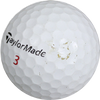"Water Moccasin" and "Cottonmouth" are common names for a sometimes nasty and potentially lethal species of snake common to the Southern regions of the United States. Its formal name is Agkistrodon Piscivorus, but it has many other nicknames including black moccasin, gaper, mangrove rattler, snap jaw, stub-tail snake, swamp lion, trap jaw, water mamba and water pilot.
And it likes hanging out around golf course ponds.
Are these bad boys really a threat to golf ball divers? Just ask one of our divers, Brett Parker. He's been bitten three times so far, and now carries his own anti-venom kit. Parker will happily display his most visible bite mark, two round, white scars on his hand between thumb and forefinger. How did he get it? He tells the story like this...
“So, I’m done for the day and stop to rinse off my hands at the edge of a pond. Suddenly I see a like-new Titleist Pro V1 right there...only a couple inches under the water. Too good to pass up, I reach for it, and just as I put my hand in, I notice an odd “pattern” under the water. But it was too late.”
Water Moccasin photographed by Brett on one of his courses.
The “pattern” was actually the back markings of a four-foot long Water Moccasin right under the surface. It locked onto Brett’s hand and then wrapped itself around his arm, forcing Brett to rip it off. A trip to the hospital for a big dose of anti-venom followed. And while the experience made Brett more cautious, it never slowed him down. In fact, he regards some of the regular golf course snakes with affection. They help keep away the people who sneak onto courses at night to collect golf balls illegally.




